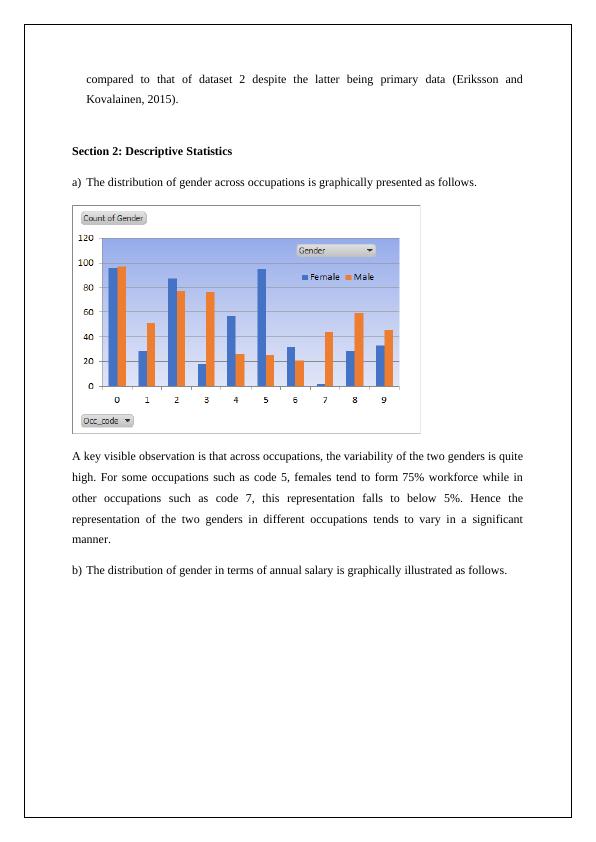Gender Gap in Workforce Management
Added on 2021-05-31
10 Pages1500 Words438 Views
STATISTICAL
MODELLING
STUDENT ID:
[Pick the date]
MODELLING
STUDENT ID:
[Pick the date]

Section 1: Introduction
a) With regards to workforce management, a crucial concern related to issue of gender gap.
This essentially refers to the lesser salary that is given to females when compared with
males and thereby amounts to discrimination driven by gender which is not permissible
under law. Studies in Australian context have confirmed presence of gender gap which in
the long run could have implications for national growth as there is less than optimum
participation from a particular gender (Livsey, 2017). In order to address this issue, the
current research is being conducted where the central question would be to access whether
gender gap is indeed present and also understand the role played by occupation in the
gender gap dynamics.
b) Dataset one is essentially comprises of secondary data about 1000 taxpayers who are
randomly selected from the data published by ATO. The given data contains information
about four key variables namely gender, occupation, gift related deduction and amount of
annual salary. There are categorical variables present in the form of occupation and gender
which are measured using a nominal scale. Also, there are quantitative variables present in
the form of gift related deduction and annual salary amount which are numerical in nature
and measured on an interval scale (Flick, 2015).
The first five cases of the unique dataset 1 provided are highlighted below.
c) There is also a primary dataset named Dataset 2 which comprises of survey results that
have been collected from the respondents themselves. Keeping in mind the research
question, only information related to the gender and annual salary have been recorded.
Also, it was felt that occupation and deduction as gift would not serve much purpose
owing to limited sample size. The sampling technique that has been used in convenience
sampling which raises potential issues in this case as it is highly possible that the sample is
not representative of the population that is of interest. A low sample size may further
lower the reliability and thus the results of dataset 1 should be held in higher credibility as
a) With regards to workforce management, a crucial concern related to issue of gender gap.
This essentially refers to the lesser salary that is given to females when compared with
males and thereby amounts to discrimination driven by gender which is not permissible
under law. Studies in Australian context have confirmed presence of gender gap which in
the long run could have implications for national growth as there is less than optimum
participation from a particular gender (Livsey, 2017). In order to address this issue, the
current research is being conducted where the central question would be to access whether
gender gap is indeed present and also understand the role played by occupation in the
gender gap dynamics.
b) Dataset one is essentially comprises of secondary data about 1000 taxpayers who are
randomly selected from the data published by ATO. The given data contains information
about four key variables namely gender, occupation, gift related deduction and amount of
annual salary. There are categorical variables present in the form of occupation and gender
which are measured using a nominal scale. Also, there are quantitative variables present in
the form of gift related deduction and annual salary amount which are numerical in nature
and measured on an interval scale (Flick, 2015).
The first five cases of the unique dataset 1 provided are highlighted below.
c) There is also a primary dataset named Dataset 2 which comprises of survey results that
have been collected from the respondents themselves. Keeping in mind the research
question, only information related to the gender and annual salary have been recorded.
Also, it was felt that occupation and deduction as gift would not serve much purpose
owing to limited sample size. The sampling technique that has been used in convenience
sampling which raises potential issues in this case as it is highly possible that the sample is
not representative of the population that is of interest. A low sample size may further
lower the reliability and thus the results of dataset 1 should be held in higher credibility as

compared to that of dataset 2 despite the latter being primary data (Eriksson and
Kovalainen, 2015).
Section 2: Descriptive Statistics
a) The distribution of gender across occupations is graphically presented as follows.
A key visible observation is that across occupations, the variability of the two genders is quite
high. For some occupations such as code 5, females tend to form 75% workforce while in
other occupations such as code 7, this representation falls to below 5%. Hence the
representation of the two genders in different occupations tends to vary in a significant
manner.
b) The distribution of gender in terms of annual salary is graphically illustrated as follows.
Kovalainen, 2015).
Section 2: Descriptive Statistics
a) The distribution of gender across occupations is graphically presented as follows.
A key visible observation is that across occupations, the variability of the two genders is quite
high. For some occupations such as code 5, females tend to form 75% workforce while in
other occupations such as code 7, this representation falls to below 5%. Hence the
representation of the two genders in different occupations tends to vary in a significant
manner.
b) The distribution of gender in terms of annual salary is graphically illustrated as follows.

End of preview
Want to access all the pages? Upload your documents or become a member.
Related Documents
Statistical Modelling - Assignmentlg...
|11
|2197
|61
Statistical Modelling - Assignment PDFlg...
|11
|1983
|83
Statistical Modelling - Assignment PDFlg...
|11
|2022
|43
Statistical Modelling Assignment PDFlg...
|12
|2377
|37
Introduction - Statistical Modelinglg...
|12
|2173
|100
(PDF) An introduction to statistical modellinglg...
|12
|2406
|48
